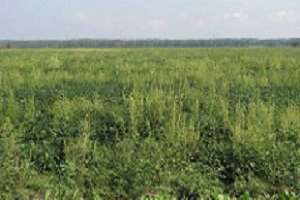Palmer amaranth and waterhemp, two common species of pigweeds in Kansas, were prevalent in many Kansas soybean fields this year, according to Dallas Peterson, weed management extension specialist at Kansas State University, and Doug Shoup, K-State southeast area extension agronomist. Many of the uncontrolled pigweeds have produced seed and will be a continuing problem in those fields in future years.

Other fields, sometimes just across the road from a weedy field, are relatively clean. The dramatic differences in pigweed populations from one field to another are most likely related to differences in the prevalence of glyphosate-resistant populations, weed seed bank, management practices, rainfall patterns, and a little bit of luck, the agronomists said.
One of the keys to getting good control of pigweeds is the use of effective preemergence herbicides as part of the weed management program, they said.
“Producers who are still trying to rely primarily on postemergence herbicides to control pigweeds are having an increasingly hard time getting good control. It used to be that glyphosate would provide excellent control of both waterhemp and Palmer amaranth even if those weeds were a foot tall or more. Other herbicide options for postemergence pigweed control in soybeans are most effective if the weeds are less than 3 inches tall,” Peterson said.
That means producers have to watch their fields closely early in the season and spray the weeds when they first see them emerging, he said. That’s an entirely different mindset than just a few years ago when glyphosate was more consistently effective on pigweeds.
Both waterhemp and Palmer amaranth grow very quickly once they have emerged, and can quickly get too tall for good control with postemergence herbicides, Shoup added. If these weeds get to be more than several inches tall, postemergence herbicide alternatives to glyphosate often just burn back the tops of the weeds but will not kill them.
Consequently, a good residual herbicide program in the spring will continue to be important for pigweed management in the future, regardless of the postemergence program, the specialists said.
Where glyphosate-resistant pigweeds have become a problem, producers may want to consider planting Liberty Link or conventional soybeans, they added. These types of soybeans also will need a diversified weed control program that utilizes residual herbicides and timely applications.
Liberty and most other postemergence pigweed herbicides need to be applied to small pigweeds, and at higher spray volumes of at least 15 gallons per acre to achieve good spray coverage, Peterson said. Liberty also works better with higher humidity and when sprayed during the daylight hours.
If weeds aren’t controlled within seven days of Liberty application, a second application seven to 10 days after the first application generally controls any surviving plants, he said. Always follow label guidelines regarding rates, adjuvants, and application procedures to achieve the best results with any herbicide treatment.
Several new herbicide-resistant traits may be fully approved for use in soybeans in the next several years, Peterson said. The traits will provide new weed control options, but also may increase the complexity of management.
“The new traits include 2,4-D-resistant soybeans, Enlist; dicamba-resistant soybeans, Roundup Ready 2 Xtend; and HPPD resistant soybeans, Balance GT and MGI. Most of these soybeans will be stacked with more than one herbicide-resistant trait, but won’t be stacked with all of the different traits,” he said.
“Regardless of the herbicide-resistant trait, the most effective weed control programs are integrated programs with multiple weed control methods and diversified herbicide programs. Postemergence treatments with these programs also will need to be applied before pigweeds exceed 3 to 4 inches tall to maximize control,” Peterson said.
Sidebar: Pigweeds in soybeans: Challenging conditions in 2016 season
MANHATTAN, Kan. -- In 2016, early season weather conditions in Kansas created challenges for pigweed control in soybeans, said Dallas Peterson, K-State Research and Extension weed management specialist.
“Many areas experienced excessive rains in late May, followed by three to four weeks of dry weather in June. Consequently, early preplant treatments may not have persisted as long as desired and started to break down,” Peterson said.
Rain is essential to activate residual herbicides, but too much rain can move the herbicide deeper into the soil and dilute the concentration in the surface zone where the pigweed is germinating.
After soils dried out, the challenges continued.
“Preemergence herbicides that were applied when it got dry enough to plant in May often did not get enough rain to activate the herbicides until several weeks later. Pigweeds that germinated during that timeframe escaped control,” Peterson said.
This scenario often complicates postemergence control decisions as there may not be a lot of weed escapes early, but there likely will be more weeds germinating when it finally rains, he
said. However, the early emerging weeds grow very rapidly with warm temperatures and quickly get beyond optimum treatment sizes.
“It probably is best to go ahead and make a timely postemergence treatment to those early emerging pigweeds and not wait for rain, as the preemergence herbicide will get activated when it finally does rain,” Peterson said. “Additionally weeds that emerge with, or soon after crop emergence are the most competitive and can result in greater yield losses than later-emerging weeds.”
“Unfortunately, the weather often doesn’t cooperate with us to get things done in a timely manner and optimize herbicide performance,” he added.
Source: k-state.edu